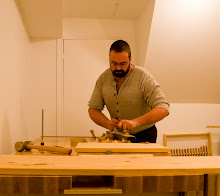
I know what you're thinking. You're wondering who in their right mind would want to sharpen chestnuts. I wondered the same thing, but wonder no longer! I just got this little dealie here from Lee Valley Tools (and pinched the image from their website). It's a knife sharpener. It's made in Canada (well, the handle is made in Canada and the company manufacturing it is Canadian), it's guaranteed for life, and it works! No, it's not going to put a polished edge on your chip-carving knives, but I had brought home my cable knife from work to try it out. My poor cable knife, used by electricians and me to cut things that really shouldn't be cut with a knife, like copper wire, and doing horrible things like digging plastic out of metal cavities with the tip, was in rather sorry shape. Not hideous shape, because, hey, it's still my knife, but it was rough. I pulled it across this pocket-sized sharpener a few times, and I could shave hairs off of my arm with it. No, not perfectly cleanly in a honed-on-16000-grit-ceramic-and-then-buffed-on-virgin-sheepskin-with-sub-micron-diamond-paste kind of way, but there was shaving going on, and it took less than 5 seconds to do the sharpening, so I was pretty darned impressed. Impressed enough that I'm typing this blog entry instead of going to sleep like I would be doing if I wasn't suffering from temporary insanity over this knife sharpener. I'll have to buy another one to keep at home because this one is going to work with me. Oh, and it cost less than $16. Sweet.













